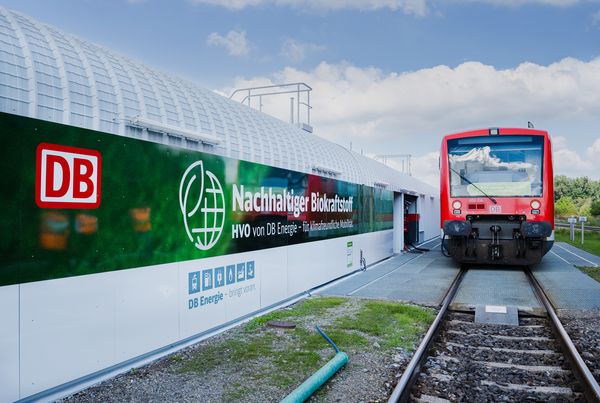Climate protection
Our contribution to climate protection
As DB Group, we will be climate-neutral by 2040.
We are using several levers to achieve this objective: the continued commitment to the electrification of lines, the expansion of the proportion of eco-power, the start of the heat transition and the shift away from diesel. In doing so, we pursue a technology-oriented approach and expand the use of alternative drives and fuels. We rely on alternative fuels such as HVO (hydrotreated vegetable oil) produced from biological residues and waste, as well as battery-powered trains and hydrogen drives.

Management approach and climate protection target
We want to become climate neutral by 2040. This means that our target year is five years ahead of that of the Federal Government for climate neutrality in Germany. Our definition of climate neutrality complies with the net zero standard of the internationally recognized Science Based Targets initiative (SBTi) and thus follows a 1.5 °C path, which we committed to in 2022. We are also part of the UN’s Race to Zero initiative. Achieving a shift in the mode of transport to the rails is key to meeting Germany’s climate protection targets. Even as the transport sector moves towards electrification, the low levels of friction generated by wheel-rail contact mean that rail travel will continue to be the most efficient form of energy use.
In order to achieve our climate protection target and to completely avoid any negative impact in the future, we have set ourselves ambitious milestones: for the share of renewable energies in the traction current mix in Germany, the power supply of stationary facilities by renewable energies and the reduction of specific greenhouse emissions.
Greenhouse gas intensity
Specific CO₂e Emissions in comparison to 2006 / % | 2022 | 2021 | 2020 |
DB Group | –42.1 | –36.1 | ‒34.4 |
Since 2021, excluding DB Arriva.
Excluding fleet vehicles, DB Schenker stationary divisions, DB Arriva and individual divisions of DB Cargo.
The share of renewable energies in the DB traction current mix in Germany is not the only measure by which we manage our progress in climate protection. We also track the development of our specific greenhouse gas emissions in comparison to 2006.
Overview of Greenhouse gas footprint
Absolute CO₂e emissions according to Scopes 1 –3 / million | 2022 | 2021 | 2020 |
Scope 1 emissions | 2.77 | 3.30 | 3.04 |
Share of total emissions (%) | 15.5 | 17.8 | 19.0 |
Scope 2 emissions 1) | 3.05 | 3.19 | 3.41 |
Share of total emissions (%) | 17.0 | 17.2 | 21.3 |
Scope 3 emissions 2) | 12.11 | 12.02 | 9.53 |
Share of total emissions (%) | 67.5 | 65.0 | 59.7 |
Total | 17.92 | 18.52 | 15.99 |
Up to and including 2020, excluding rail freight transport from/to China by DB Cargo and DB Schenker. Double accounting may be included in 2021, meaning that the values may be slightly higher. Upstream fuel- and energy-related emissions (Scope 3.3 as per the GHG Protocol) are reported in Scopes 1 and 2.
Individual figures are rounded and therefore may not add up.
1) Market-based approach.
2) Category 3.4 emissions according to the GHG protocol.
Our greenhouse gas footprint shows the amount of greenhouse gases that we emitted in one calendar year. It is made up of:
- our greenhouse gas emissions from the entirety of the rail and road fleet owned by DB Group, stationary facilities such as stations or workshops (Scope 1 and 2) and
- emissions from transport and transport services commissioned by DB Group (Scope 3.4 in accordance with the GHG Protocol).
The specific greenhouse gas emissions and our climate protection target are calculated on the basis of absolute greenhouse gas emissions within the limits set.
Outlook
ANTICIPATED DEVELOPMENT | 2022 | 2023 |
Specific greenhouse gas emissions in comparison to 2006 (%) | –42.1 | ‒39.9 |
- The slight decline in specific greenhouse gas emissions compared with 2006, which is forecasted for 2023, is mainly due to the changed energy mix (phase-out of nuclear energy) in DB traction current.